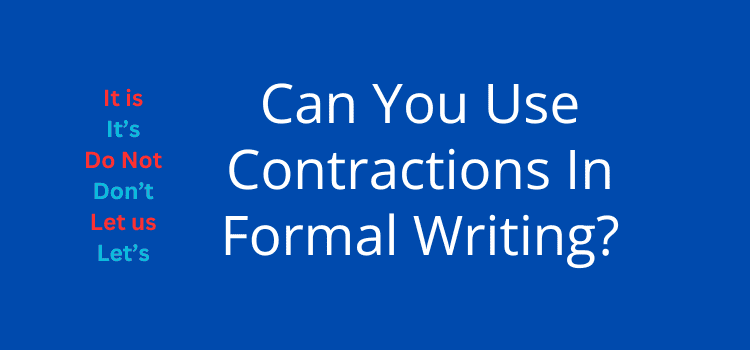
As a general rule, most style guides and grammar references state that you should not use contractions in formal writing.
However, it is a point open to debate by writers, editors, and grammarians.
Some argue that language should be more relaxed now and that the days of stiff, formal writing are in the past.
It might be true to a certain extent, but it is not the rule that has changed. It is how and what we write that has.
Defining formal writing
We rarely write letters anymore because email has become the most common form of correspondence.
It is one of the main reasons why writing has become less formal.
Even in business or government correspondence, contractions in formal writing are more acceptable now.
But by including contractions, a text becomes less formal, even to the point of becoming informal.
Strict formal writing still exists, especially in fields such as academic, scientific, technical, legal, and business writing.
In these types of texts, it is rare to use contractions.
Another form is journalism.
If you read The New York Times, you may notice that its journalists rarely, if ever, use contractions, except when quoting someone.
Formal writing still exists, and the rules regarding contractions still apply.
It is only because we tend to write less formally now that we question the rule.
Formal or informal writing?
The criteria never changed in my years of preparing students for Cambridge writing examinations.
To pass the examination, students had to demonstrate that they could write both formal and informal texts.
The only way to succeed was to know the difference between them.
A formal text needed to have these features:
1. No contractions.
2. Single-word verbs. (no phrasal verbs)
3. Longer linking words. (e.g., however, therefore, moreover.)
Features of an informal text
1. Use of contractions.
2. Use of phrasal verbs.
3. Short linking words. (e.g., but, so.)
Of course, there is much more to differentiating between formal and informal writing.
But for my students, if they could control these fundamental factors, they would probably pass the examination.
Yet, for writers, these basics are still a good guide to controlling formality in writing.
What do the experts say?
Style guides have differing opinions about the topic.
APA Style says this: “Contractions are a part of informal writing. Thus, avoid contractions in scholarly writing….”
MLA Style gives this advice: “Contractions may not be suitable for all types of formal writing.”
It also gives a good example of contractions causing confusion.
The teacher’s key to the classroom and can’t be replaced.
This phrase could be read as possessive, the key the teacher owns, instead of the verb to be, the teacher is.
Cambridge Dictionary: “Contractions are usually not appropriate in formal writing.”
Australian Government Style Guide: “Contractions are shortened words. People will read and understand them depending on their context. Avoid them in formal content.”
The Chicago Manual of Style: “In writing that is both formal and technical, contractions are still generally discouraged.”
You can find many more opinions regarding formal writing and the use of contractions.
However, most agree that they should not be used in formal texts.
The rule has not changed
The rule is the same, but writing is changing.
Contractions always change the register and formality of a text.
A covering letter for a job application used to require a high level of formality. But today, it is not uncommon, and probably acceptable, to use contractions to reduce the formality.
Almost all forms of online writing are informal now. This includes articles, blog posts, and even business pages.
Emails are generally quite informal, even when communicating with customers, clients, or superiors.
Email writing is a perfect example of the contraction rule not changing.
It is the style of our communication that has changed and become increasingly less formal.
Advice for new writers
There is an adage that is always applicable to this topic.
When in doubt, spell it out.
Contractions can cause confusion, especially double contractions such as wouldn’t’ve or mightn’t’ve.
Another one that can be problematic is contractions with a d, like I’d. Is it I had or I would?
If you are not sure it is clear, use the full form.
Also, consider the context of your writing.
If your reader or readers are expecting a highly formal tone, use full words.
But if you are writing a business report with a conversational tone, contractions might be acceptable.
For fiction writers, contractions are almost always used in dialogue. In the narrative, it is a style choice.
One last point is that you need to be consistent. If you want to maintain a very high level of formality, do not use any contractions in a text.
But if you are aiming for a more informal tone, use contractions as long as they do not cause confusion or possible misunderstanding.
It is up to you to choose the voice and tone of your writing.
Summary
English teaching has undoubtedly kept me obeying the rules. After so many years of teaching writing, it is a habit.
But that is not to say that breaking the rules is a bad thing, except that you need to know the rules before you can break them.
However, when it comes to not using contractions in formal writing, I still believe the rule applies.
Without it, there would be no point of difference between formal and informal writing.
You may have noticed that I have maintained a formal voice in this article by avoiding contractions, which is not my usual style of writing articles.
Yet, I do not believe it is overly formal or cold because I also used elements of informal writing, such as short linking words, simple verbs, and active voice.
This is the beauty of writing. You are in charge, and you make the decisions.
It is what differentiates your writing voice, tone, and style from others.
Related Reading: How To Write In Formal Register For Essays And Letters



